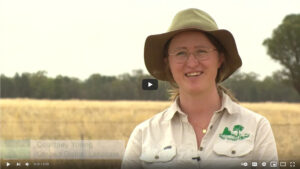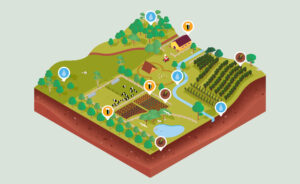National NRM update for June 2021. This update represents just a handful among the hundreds of NRM projects going on across Australia, which are made possible through funding from the Australian Government’s National Landcare Program and from respective State governments.
 Through an NLP Smart Farms Small Grant, Corowa District Landcare in NSW has been investigating and trialling perennial native grass cultivation and the role of native grasses in our landscapes. Take a look at the video to find out how the trial explores the different ways of cultivating native grass for different commercial markets (seed for revegetation, seed for pastures, and seed for edible grain). https://www.youtube.com/watch?v=j_bVOuBmjDs
Through an NLP Smart Farms Small Grant, Corowa District Landcare in NSW has been investigating and trialling perennial native grass cultivation and the role of native grasses in our landscapes. Take a look at the video to find out how the trial explores the different ways of cultivating native grass for different commercial markets (seed for revegetation, seed for pastures, and seed for edible grain). https://www.youtube.com/watch?v=j_bVOuBmjDs
 Western Australia's Northern Agricultural Catchments Council (NACC), working with project partner Tierra Australia, have established the Chapman Catchment – Collaborative Landscape Scale Regeneration project. The Chapman Catchment is a long-established, well managed, and highly productive dryland farming area (crops and pastures) that also incorporates some intensive diversification activities.
Western Australia's Northern Agricultural Catchments Council (NACC), working with project partner Tierra Australia, have established the Chapman Catchment – Collaborative Landscape Scale Regeneration project. The Chapman Catchment is a long-established, well managed, and highly productive dryland farming area (crops and pastures) that also incorporates some intensive diversification activities.
This catchment presents a unique opportunity to demonstrate a broad range of regenerative practices across varying properties and six demonstration sites will be developed. Together, these properties will showcase the potential for ‘catchment scale’ agricultural systems change and landscape regeneration. This project is supported by funding from the WA Government’s State NRM Program, find out more at the link: https://www.nacc.com.au/landscape-scale-regeneration/
 A series of visits this year to the Alpine region of north east Victoria is key to helping Jaithmathang Senior Elders rekindle their spiritual belonging to their Jaithmathang Ancient Sacred Yero Mountains and High Plains Country. They made the journey from Sydney to Mt Hotham as part of the Mountain Pygmy-possum Recovery Project supported by North East CMA and funded through the NLP.
A series of visits this year to the Alpine region of north east Victoria is key to helping Jaithmathang Senior Elders rekindle their spiritual belonging to their Jaithmathang Ancient Sacred Yero Mountains and High Plains Country. They made the journey from Sydney to Mt Hotham as part of the Mountain Pygmy-possum Recovery Project supported by North East CMA and funded through the NLP.
 Feral water buffalo numbers in the NT continue to increase, with current estimates across the Top End well in excess of 150 000 animals. Territory NRM is working with the Bawinanga Aboriginal Corporation's Djelk Rangers to collect data for a monitoring program that will track the outcome of buffalo management activities being undertaken in the region.
Feral water buffalo numbers in the NT continue to increase, with current estimates across the Top End well in excess of 150 000 animals. Territory NRM is working with the Bawinanga Aboriginal Corporation's Djelk Rangers to collect data for a monitoring program that will track the outcome of buffalo management activities being undertaken in the region.
Funded through the NLP, this work is being undertaken as part of a regional project to protect the natural values of West Arnhem Land and Kakadu National Park through the strategic management of feral animals and invasive weeds.
 Profiling of saltmarsh communities across South Australia's Eyre Peninsula is nearly at the half-way mark, recording exactly what species are in the saltmarsh, analysing changes to sites over time and shedding new light on organic blue carbon stocks. The Eyre Peninsula Landscape Board is working with Adelaide University, local surveyors, Far West Coast Rangers and the Department for Environment and Water’s Coast and Marine Branch to collect a range of information, including vegetation type, vegetation height and density, land height, evidence of animal presence and any signs of disturbance.
Profiling of saltmarsh communities across South Australia's Eyre Peninsula is nearly at the half-way mark, recording exactly what species are in the saltmarsh, analysing changes to sites over time and shedding new light on organic blue carbon stocks. The Eyre Peninsula Landscape Board is working with Adelaide University, local surveyors, Far West Coast Rangers and the Department for Environment and Water’s Coast and Marine Branch to collect a range of information, including vegetation type, vegetation height and density, land height, evidence of animal presence and any signs of disturbance.
These surveys are an important step in effectively managing the more than 3,000km of saltmarsh coastline across the Eyre Peninsula. Read more at the link: https://www.landscape.sa.gov.au/ep/news/20210624-saltmarsh-survey
 Twenty rehabilitated western ringtail possums have been released at a property in Gracetown, WA following a term spent at the Possum Finishing School, preparing them for life in the wild. South West Catchments Council are working with Fostering and Assistance for Wildlife Needing Aid (FAWNA), the University of Western Australia and the Department of Biodiversity and Conservation to determine survival rates of rehabilitated pouch young after release into the wild and investigate which factors improve their survival.
Twenty rehabilitated western ringtail possums have been released at a property in Gracetown, WA following a term spent at the Possum Finishing School, preparing them for life in the wild. South West Catchments Council are working with Fostering and Assistance for Wildlife Needing Aid (FAWNA), the University of Western Australia and the Department of Biodiversity and Conservation to determine survival rates of rehabilitated pouch young after release into the wild and investigate which factors improve their survival.
Check out the video for some great footage of the released possums: https://www.youtube.com/watch?v=JkZe3q_-h3o

With the support of 33 landholders, recent feral pig surveys and aerial control measures across more that 4,400 ha of Queensland's Giru region resulted in sixteen feral pigs being located and shot from the air. Feral pigs threaten natural landscapes in many ways, including spreading weeds, and degrading important wetland bird habitat an aerial shooting is considered the most humane form of control, as the visibility from above helps ensure maximum speed and accuracy.
This work is part of the Restoring the Bowling Green Bay Ramsar wetlands project, delivered by NQ Dry Tropics and funded through the NLP. Ongoing work is underway to engage with landholders across the Giru area, with the intention of forming a local 'cluster group', to improve the coordination and efficiency of future feral pig control efforts.
 Once ranging from Queensland to Victoria and South Australia, the population and distribution of Plains-wanderers have declined dramatically, with estimates as low as only 250 mature birds remaining in the wild. With support from Murray Local Land Services and Riverina Local Land Services, 23 landholders across the Murray and Riverina regions are doing their part to help this bird by actively managing 13,000 ha of Plains-wanderer habitat.
Once ranging from Queensland to Victoria and South Australia, the population and distribution of Plains-wanderers have declined dramatically, with estimates as low as only 250 mature birds remaining in the wild. With support from Murray Local Land Services and Riverina Local Land Services, 23 landholders across the Murray and Riverina regions are doing their part to help this bird by actively managing 13,000 ha of Plains-wanderer habitat.Through the project, landholders are establishing stock containment areas and installing new feed, water, and fence infrastructure to strategically graze paddocks and maintain the grasslands in a suitable condition for plains-wanderers year-round. Landholders are undertaking coordinated fox control to reduce the threat of predation and also controlling rabbits and boxthorn to ensure the specific habitat requirements can be maintained.
This project is funded through the NLP and the NSW Government's Saving Our Species Program.
 In WA, Wheatbelt NRM is working in partnership with soil experts Bioscence on a woodland Environmental DNA (eDNA) program to determine if management interventions have any impact on the diversity of soil bacteria and mychorrizal fungi. These are known to be essential for the long-term health of woodland ecosystems.
In WA, Wheatbelt NRM is working in partnership with soil experts Bioscence on a woodland Environmental DNA (eDNA) program to determine if management interventions have any impact on the diversity of soil bacteria and mychorrizal fungi. These are known to be essential for the long-term health of woodland ecosystems.
Early results from farm and reserve vegetation show a significant range of microbial diversity and that the soils within vegetation on selected farm sites have similar bacterial diversity compared to soils within reserved areas. Patterns of community structure are strongly related to salinity and pH levels in the soil. https://wheatbeltnrm.org.au/whats-happening/news/healthy-environments/what-edna-telling-us-about-health-our-woodlands
 Thanks to a funding boost from South Australia's State Government, feral cat removal activities on Kangaroo Island's Dudley Peninsula will get the resources it needs to see the program through. These activities are part of a broader program to eradicate feral cats from the island by 2030. If successful, Kangaroo Island would be the largest inhabited island without a feral cat population.
Thanks to a funding boost from South Australia's State Government, feral cat removal activities on Kangaroo Island's Dudley Peninsula will get the resources it needs to see the program through. These activities are part of a broader program to eradicate feral cats from the island by 2030. If successful, Kangaroo Island would be the largest inhabited island without a feral cat population.
For more information, visit: https://www.theislanderonline.com.au/story/7304088/feral-cats-curtailed-on-kangaroo-island/
 The Melbourne Foodbowl Virtual Farm is an interactive education tool about healthy food production in Melbourne’s Foodbowl. It provides information on how farmers manage natural assets on their farm, and how key elements of a farm system interact to contribute to farm sustainability. This resource supports teachers and students with classroom resources, activities and lesson plans for soils and water catchments, and is also a good resource for anyone interested in learning more about sustainable farming in Melbourne’s Foodbowl.
The Melbourne Foodbowl Virtual Farm is an interactive education tool about healthy food production in Melbourne’s Foodbowl. It provides information on how farmers manage natural assets on their farm, and how key elements of a farm system interact to contribute to farm sustainability. This resource supports teachers and students with classroom resources, activities and lesson plans for soils and water catchments, and is also a good resource for anyone interested in learning more about sustainable farming in Melbourne’s Foodbowl.
It was developed as part of the Farms2Schools program - developed by Port Phillip & Westernport CMA in partnership with AUSVEG VIC, and was supported by the Victorian Government’s Working for Victoria initiative. https://virtualfarm.melbournefoodbowl.com.au/home.html
 South Australia is making a historic push to have Adelaide become the world’s second National Park City.This concept originated in the UK, with London being named the first National Park City in 2019. Greater London has nearly 50 per cent green cover making it one of the world’s most vegetated cities.
South Australia is making a historic push to have Adelaide become the world’s second National Park City.This concept originated in the UK, with London being named the first National Park City in 2019. Greater London has nearly 50 per cent green cover making it one of the world’s most vegetated cities.
Adelaide has been consistently rated as one of the world’s most liveable cities, and boasts 30% green space, and diverse wildlife from 1,080 plant species and 300 species of birds, to 60 fish species and 40 mammal species, plus more than 45 species of reptiles. Find out more at www.adelaidenationalparkcity.org
